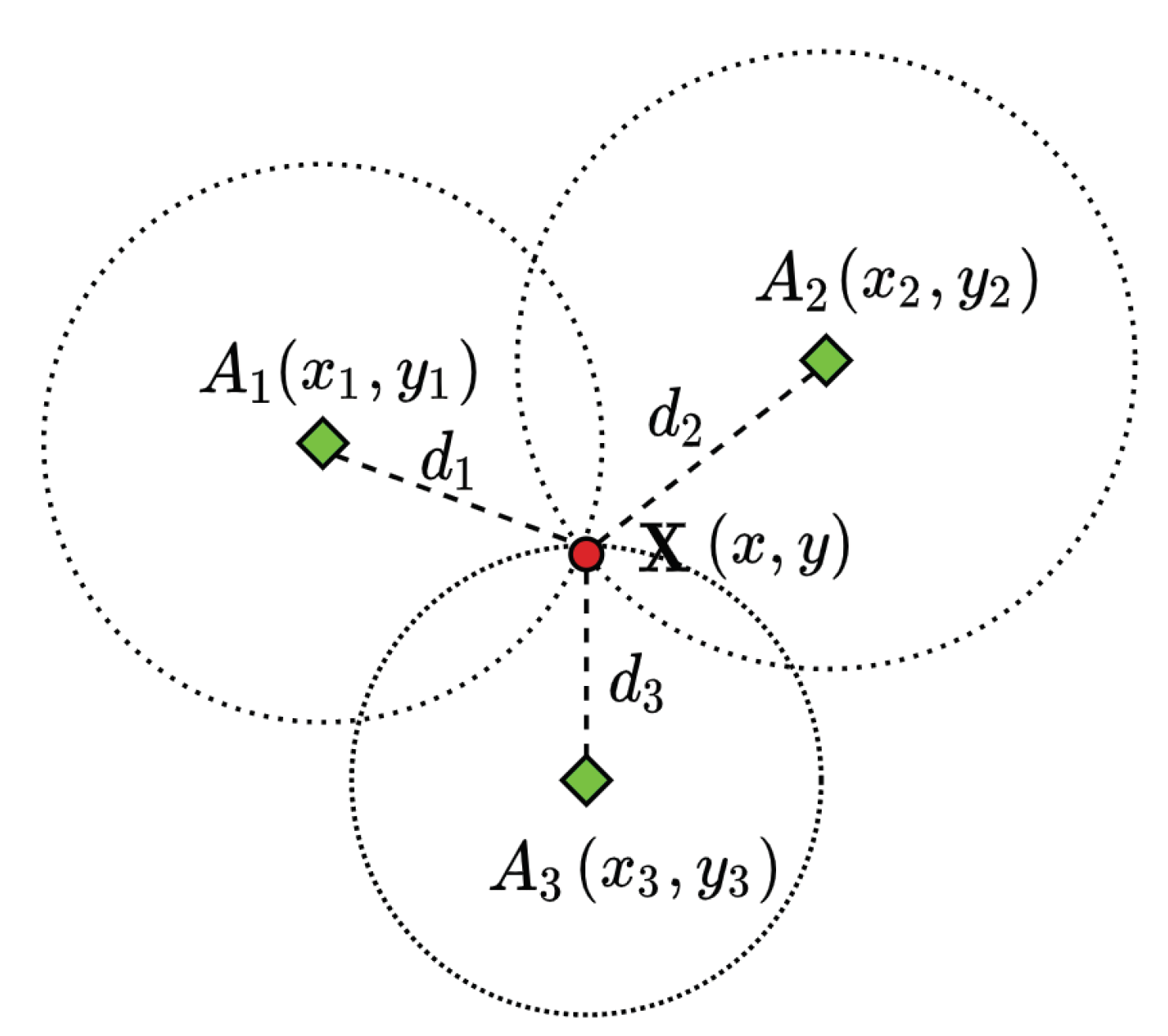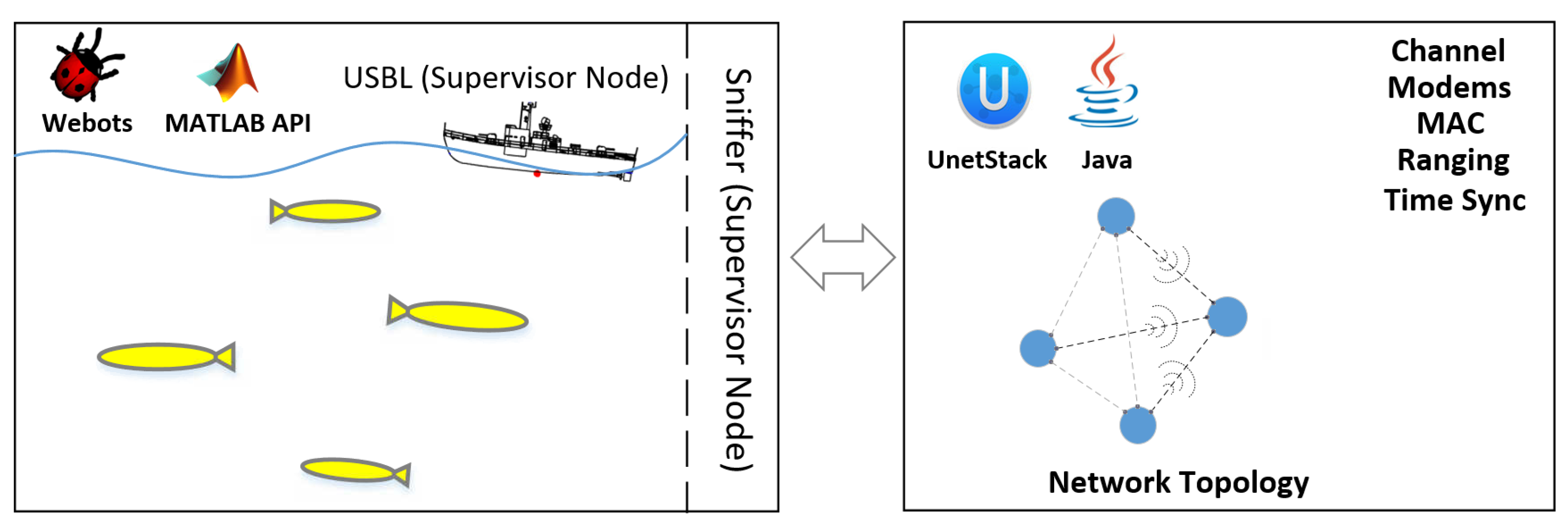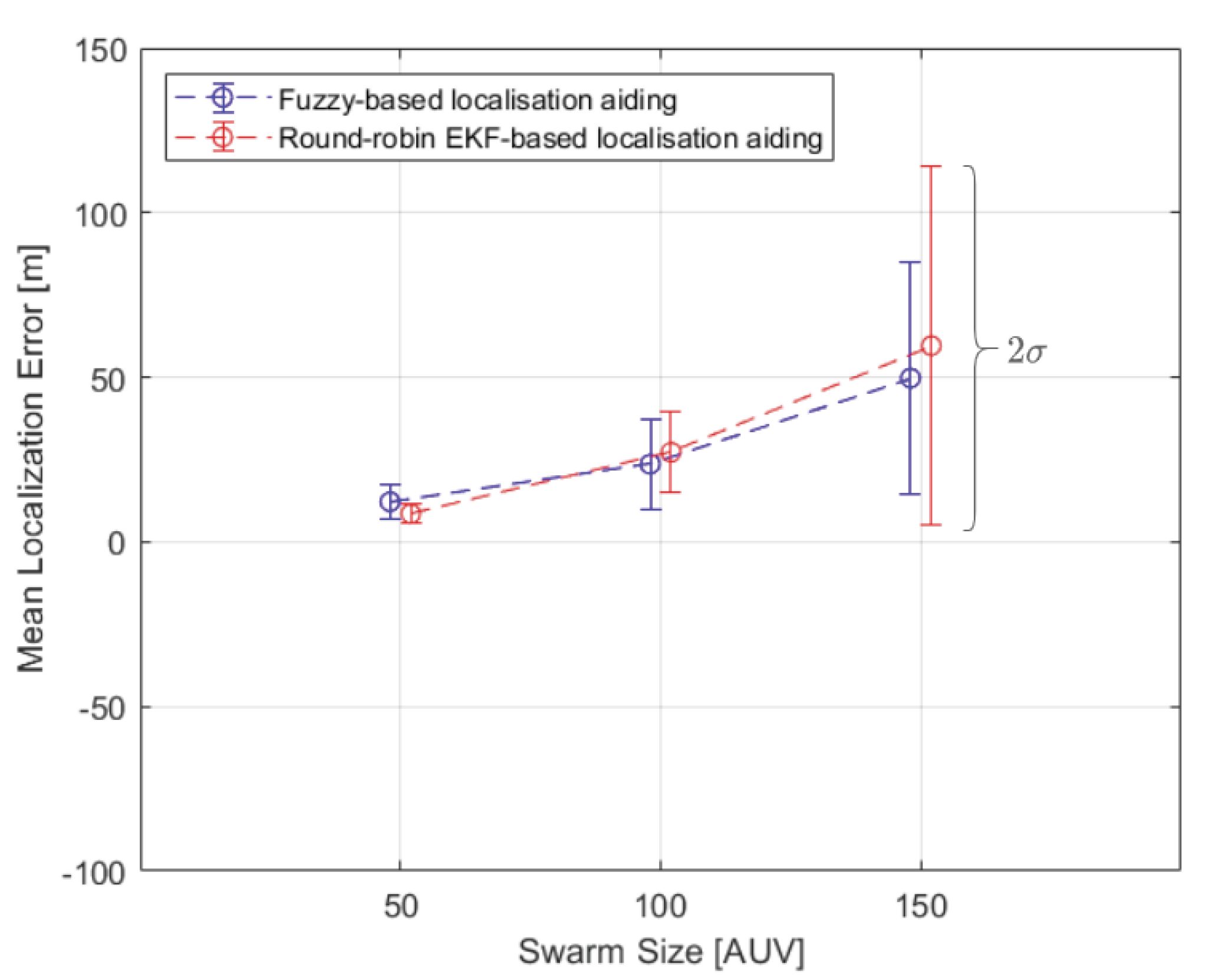A Fuzzy Cooperative Localisation Framework for Underwater Robotic Swarms
Abstract
:1. Introduction
2. Underwater Localisation Methods
2.1. Time of Flight (ToF) Acoustic Navigation
2.2. Inertial Navigation System
2.3. Least-Squares Trilateration
3. Fuzzy-Based Localisation
4. Simulation
4.1. Simulation Platform
4.2. Implementation
4.3. Simulation Scenario and Settings
4.4. Results and Analysis
5. Conclusions
Author Contributions
Funding
Acknowledgments
Conflicts of Interest
Appendix A
Appendix A.1.
- IF is Shallow AND is Short THEN is .
- IF is Not Available AND is Not Enough THEN is .
- IF is Low AND is Available AND is Not Enough AND is Long THEN is .
- IF is Low AND is Not Available AND is Enough AND is Long THEN is .
- IF is Available AND is Long THEN is .
- IF is High AND is Available AND is Not Enough AND is Mid THEN is .
- IF is High AND is Not Available AND is Enough AND is Long THEN is .
- IF is Shallow AND is High AND is Not Available AND is Enough AND is Mid THEN is .
- IF is Shallow AND is High AND is Available AND is Enough AND is Mid THEN is .
- IF is Available AND is Mid THEN is .
- IF is Low AND is Available AND is Enough AND is Long THEN is .
- IF is Deep AND is High AND is Available AND is Mid THEN is .
- IF is Deep AND is High AND is Available AND is Long THEN is .
- IF is Shallow AND is High AND is Available AND is Long THEN is .
- IF is High AND is Not Available AND is Enough AND is Long THEN is .
- IF is Deep AND is High AND is Not Available AND is Enough AND is Mid THEN is .
- IF is High AND is Available AND is Long THEN is .
- IF is High AND is Available AND is Mid THEN is .
- IF is High AND is Not Available AND is Enough AND is Long THEN is .
- IF is Not Available AND is Enough AND is Mid THEN is .
- IF is Deep AND is Available THEN is .
- IF is Deep AND is Available THEN is .
- IF is Deep AND is Not Available AND is Enough AND is Short THEN is .
Appendix A.2.
| Swarm Size | H0 REJECTED | p-Value | Degree of Freedom | t-Statistics | Critical Value |
|---|---|---|---|---|---|
| 50 | No | 1.0000 | 75.45 | −4.35 | 1.6653 |
| 100 | Yes | 0.0252 | 194.48 | 1.96 | 1.6527 |
| 150 | Yes | 0.0324 | 255.45 | 1.85 | 1.6508 |
References
- Şahin, E. Swarm robotics: From sources of inspiration to domains of application. In Proceedings of the International Workshop on Swarm Robotics, Santa Monica, CA, USA, 17 July 2004; pp. 10–20. [Google Scholar]
- Chen, J.; Gauci, M.; Li, W.; Kolling, A.; Groß, R. Occlusion-based cooperative transport with a swarm of miniature mobile robots. IEEE Trans. Robot. 2015, 31, 307–321. [Google Scholar] [CrossRef]
- Arafat, M.Y.; Moh, S. Localization and Clustering Based on Swarm Intelligence in UAV Networks for Emergency Communications. IEEE Internet Things J. 2019, 6, 8958–8976. [Google Scholar] [CrossRef]
- Wang, X.; Feng, W.; Chen, Y.; Ge, N. UAV Swarm-Enabled Aerial CoMP: A Physical Layer Security Perspective. IEEE Access 2019, 7, 120901–120916. [Google Scholar] [CrossRef]
- Chung, S.; Paranjape, A.A.; Dames, P.; Shen, S.; Kumar, V. A Survey on Aerial Swarm Robotics. IEEE Trans. Robot. 2018, 34, 837–855. [Google Scholar] [CrossRef] [Green Version]
- Giuggioli, L.; Potts, J.R.; Rubenstein, D.I.; Levin, S.A. Stigmergy, collective actions, and animal social spacing. Proc. Natl. Acad. Sci. USA 2013, 110, 16904–16909. [Google Scholar] [CrossRef] [Green Version]
- Ferri, G.; Munafò, A.; Tesei, A.; Braca, P.; Meyer, F.; Pelekanakis, K.; Petroccia, R.; Alves, J.; Strode, C.; LePage, K. Cooperative robotic networks for underwater surveillance: an overview. IET Radar Sonar Navig. 2017, 11, 1740–1761. [Google Scholar] [CrossRef]
- Petillot, Y.R.; Antonelli, G.; Casalino, G.; Ferreira, F. Underwater Robots: From Remotely Operated Vehicles to Intervention-Autonomous Underwater Vehicles. IEEE Robot. Autom. Mag. 2019, 26, 94–101. [Google Scholar] [CrossRef]
- Tal, A.; Klein, I.; Katz, R. Inertial navigation system/Doppler velocity log (INS/DVL) fusion with partial DVL measurements. Sensors 2017, 17, 415. [Google Scholar] [CrossRef]
- Snyder, J. Doppler Velocity Log (DVL) navigation for observation-class ROVs. In Proceedings of the OCEANS 2010 MTS/IEEE SEATTLE, Seattle, WA, USA, 20–23 September 2010; pp. 1–9. [Google Scholar]
- Stojanovic, M.; Preisig, J. Underwater acoustic communication channels: Propagation models and statistical characterization. IEEE Commun. Mag. 2009, 47, 84–89. [Google Scholar] [CrossRef]
- Napolitano, F.; Chapelon, A.; Urgell, A.; Paturel, Y. PHINS: The autonomous navigation solution. Sea Technol. 2004, 45, 55–58. [Google Scholar]
- Medagoda, L.; Kinsey, J.C.; Eilders, M. Autonomous Underwater Vehicle localization in a spatiotemporally varying water current field. In Proceedings of the 2015 IEEE International Conference on Robotics and Automation (ICRA), Seattle, WA, USA, 26–30 May 2015; pp. 565–572. [Google Scholar] [CrossRef]
- Caiti, A.; Munafò, A.; Viviani, R. Adaptive on-line planning of environmental sampling missions with a team of cooperating autonomous underwater vehicles. Int. J. Control 2007, 80, 1151–1168. [Google Scholar] [CrossRef]
- Leonard, N.E.; Paley, D.A.; Davis, R.E.; Fratantoni, D.M.; Lekien, F.; Zhang, F. Coordinated control of an underwater glider fleet in an adaptive ocean sampling field experiment in Monterey Bay. J. Field Robot. 2010, 27, 718–740. [Google Scholar] [CrossRef]
- Alvarez, A.; Mourre, B. Oceanographic Field Estimates from Remote Sensing and Glider Fleets. J. Atmos. Ocean. Technol. 2012, 29, 1657–1662. [Google Scholar] [CrossRef] [Green Version]
- Ferri, G.; Cococcioni, M.; Alvarez, A. Mission planning and decision support for underwater glider networks: A sampling on-demand approach. Sensors 2016, 16, 28. [Google Scholar] [CrossRef] [PubMed]
- Caiti, A.; Calabrò, V.; Dini, G.; Lo Duca, A.; Munafò, A. Secure Cooperation of Autonomous Mobile Sensors Using an Underwater Acoustic Network. Sensors 2012, 12, 1967–1989. [Google Scholar] [CrossRef] [PubMed] [Green Version]
- Webster, S.E.; Eustice, R.M.; Singh, H.; Whitcomb, L.L. Advances in single-beacon one-way-travel-time acoustic navigation for underwater vehicles. Int. J. Robot. Res. 2012, 31, 935–950. [Google Scholar] [CrossRef]
- Webster, S.E.; Walls, J.M.; Whitcomb, L.L.; Eustice, R.M. Decentralized extended information filter for single-beacon cooperative acoustic navigation: Theory and experiments. IEEE Trans. Robot. 2013, 29, 957–974. [Google Scholar] [CrossRef]
- Caiti, A.; Calabrò, V.; Fabbri, T.; Fenucci, D.; Munafò, A. Underwater communication and distributed localization of AUV teams. In Proceedings of the 2013 MTS/IEEE OCEANS—Bergen, Bergen, Norway, 10–14 June 2013; pp. 1–8. [Google Scholar]
- Bahr, A.; Leonard, J.J.; Fallon, M.F. Cooperative localization for autonomous underwater vehicles. Int. J. Robot. Res. 2009, 28, 714–728. [Google Scholar] [CrossRef]
- Fenucci, D.; Munafò, A.; Phillips, A.B.; Neasham, J.; Gold, N.; Sitbon, J.; Vincent, I.; Sloane, T. Development of smart networks for navigation in dynamic underwater environments. In Proceedings of the 2018 IEEE/OES Autonomous Underwater Vehicle Workshop (AUV), Porto, Portugal, 6–9 November 2018; pp. 1–6. [Google Scholar]
- Phillips, A.B.; Gold, N.; Linton, N.; Harris, C.A.; Richards, E.; Templeton, R.; Thuné, S.; Sitbon, J.; Muller, M.; Vincent, I.; et al. Agile design of low-cost autonomous underwater vehicles. In Proceedings of the OCEANS 2017—Aberdeen, Aberdeen, UK, 19–22 June 2017; pp. 1–7. [Google Scholar]
- Munafò, A.; Śliwka, J.; Petroccia, R. Localisation Using Undersea Wireless Networks. In Proceedings of the 2018 OCEANS—MTS/IEEE Kobe Techno-Oceans (OTO), Kobe, Japan, 28–31 May 2018; pp. 1–7. [Google Scholar]
- Sabra, A.; Fung, W.; Radhakrishna, P. Confidence-based Underwater Localization Scheme for Large-Scale Mobile Sensor Networks. In Proceedings of the OCEANS 2018 MTS/IEEE Charleston, Charleston, SC, USA, 22–25 October 2018; pp. 1–6. [Google Scholar] [CrossRef]
- Sabra, A.; Fung, W.K.; Churn, P. Multi-objective Optimization of Confidence-Based Localization in Large-Scale Underwater Robotic Swarms. In Distributed Autonomous Robotic Systems; Correll, N., Schwager, M., Otte, M., Eds.; Springer International Publishing: Cham, Switzerland, 2019; pp. 109–123. [Google Scholar]
- Sabra, A.; Fung, W. Dynamic localization plan for underwater mobile sensor nodes using fuzzy decision support system. In Proceedings of the OCEANS 2017—Anchorage, Anchorage, AK, USA, 18–21 September 2017; pp. 1–8. [Google Scholar]
- Fang, B.T. Trilateration and extension to global positioning system navigation. J. Guid. Control. Dyn. 1986, 9, 715–717. [Google Scholar] [CrossRef]
- Webots. Commercial Mobile Robot Simulation Software. Available online: http://www.cyberbotics.com (accessed on 20 July 2020).
- UnetStack. The Underwater Networks Project. Available online: https://unetstack.net (accessed on 20 July 2020).
- Dubois, D.J. Fuzzy Sets and Systems: Theory and Applications; Academic Press: New York, USA, 1980; Volume 144. [Google Scholar]
- Eichfeld, H.; Kunemund, T.; Menke, M. A 12b general-purpose fuzzy logic controller chip. IEEE Trans. Fuzzy Syst. 1996, 4, 460–475. [Google Scholar] [CrossRef]
- Morgado, M.; Oliveira, P.; Silvestre, C.; Vasconcelos, J.F. USBL/INS tightly-coupled integration technique for underwater vehicles. In Proceedings of the 2006 9th International Conference on Information Fusion, Florence, Italy, 10–13 July 2006; pp. 1–8. [Google Scholar]
- Arpaci-Dusseau, R.H.; Arpaci-Dusseau, A.C. Scheduling Introduction. In Operating Systems: Three Easy Pieces; Arpaci-Dusseau Books: Madison, WI, USA, 2014; Chapter Scheduling; pp. 63–74. [Google Scholar]
- Kinsey, J.C.; Eustice, R.M.; Whitcomb, L.L. A survey of underwater vehicle navigation: Recent advances and new challenges. In Proceedings of the IFAC Conference of Manoeuvering and Control of Marine Craft. Lisbon, Lisbon, Portugal, 20–22 September 2006; Volume 88, pp. 1–12. [Google Scholar]
- Sonardyne International Limited. Ranger USBL Acoustic Positioning System for DP Reference and Survey Positioning Ranger USBL DP Reference and Survey Positioning. Ranger Usbl Datasheet. 2009, pp. 1–6. Available online: https://www.sonardyne.com/product/ranger-2-subsea-positioning-usbl (accessed on 20 July 2020).
- Tan, H.P.; Diamant, R.; Seah, W.K.; Waldmeyer, M. A survey of techniques and challenges in underwater localization. Ocean. Eng. 2011, 38, 1663–1676. [Google Scholar] [CrossRef] [Green Version]
- Arkhipov, M. Utilizing Johnson Solids for Designing Multielement USBL Systems. IEEE J. Ocean. Eng. 2016, 41, 783–793. [Google Scholar] [CrossRef]
- Bingham, B.; Seering, W. Hypothesis grids: improving long baseline navigation for autonomous underwater vehicles. IEEE J. Ocean. Eng. 2006, 31, 209–218. [Google Scholar] [CrossRef]
- SBG Systems. Ellipse 2 Micro Series. Ellipse 2 Micro Series Datasheet. 2018, pp. 1–4. Available online: https://www.sbg-systems.com/products/ellipse-micro-series (accessed on 20 July 2020).
- NOAA. Geomagnetism. National Centers for Environmental Information. Available online: https://www.ngdc.noaa.gov/geomag/geomag.shtml (accessed on 20 July 2020).
- Kok, M.; Hol, J.D.; Schön, T.B. Using Inertial Sensors for Position and Orientation Estimation. Found. Trends Signal Process. 2017, 11, 1–153. [Google Scholar] [CrossRef] [Green Version]
- Teymorian, A.Y.; Cheng, W.; Ma, L.; Cheng, X.; Lu, X.; Lu, Z. 3D Underwater Sensor Network Localization. IEEE Trans. Mob. Comput. 2009, 8, 1610–1621. [Google Scholar] [CrossRef]
- Thomas, F.; Ros, L. Revisiting trilateration for robot localization. IEEE Trans. Robot. 2005, 21, 93–101. [Google Scholar] [CrossRef] [Green Version]
- Sommerville, D.M.L.Y. An Introduction to the Geometry of n Dimensions; Dover: New York, USA, 1958. [Google Scholar]
- Coope, I. Reliable computation of the points of intersection of n spheres in Rn. ANZIAM J. 2000, 42, 461–477. [Google Scholar] [CrossRef] [Green Version]
- Foy, W.H. Position-Location Solutions by Taylor-Series Estimation. IEEE Trans. Aerosp. Electron. Syst. 1976, AES-12, 187–194. [Google Scholar] [CrossRef]
- Navidi, W.; Murphy, W.S.; Hereman, W. Statistical methods in surveying by trilateration. Comput. Stat. Data Anal. 1998, 27, 209–227. [Google Scholar] [CrossRef]
- Sand, S.; Dammann, A.; Mensing, C. Position Estimation. In Positioning in Wireless Communications Systems; John Wiley & Sons, Ltd: Hoboken, NJ, USA, 2013; pp. 69–99. [Google Scholar] [CrossRef]
- Kennedy, J.; Eberhart, R. Particle swarm optimization. In Proceedings of the ICNN’95—International Conference on Neural Networks, Perth, Australia, 27 November–1 December 1995; Volume 4, pp. 1942–1948. [Google Scholar] [CrossRef]
- Pedersen, M.E.H. Good Parameters for Particle Swarm Optimization; Tech. Rep. HL1001; Hvass Lab.: Copenhagen, Denmark, 2010; pp. 1551–3203. [Google Scholar]
- Zhou, Y. An efficient least-squares trilateration algorithm for mobile robot localization. In Proceedings of the 2009 IEEE/RSJ International Conference on Intelligent Robots and Systems, St. Louis, MO, USA, 10–15 October 2009; pp. 3474–3479. [Google Scholar] [CrossRef]
- Zadeh, L.A. The concept of a linguistic variable and its application to approximate reasoning. In Learning Systems and Intelligent Robots; Springer: New York, NY, USA, 1974; pp. 1–10. [Google Scholar]
- Grewal, M.S.; Andrews, A.P. Kalman Filtering: Theory and Practice with MATLAB, 2nd ed.; John Wiley & Sons, Ltd.: Hoboken, NJ, USA, 2001. [Google Scholar]
- Petritoli, E.; Cagnetti, M.; Leccese, F. Simulation of Autonomous Underwater Vehicles (AUVs) Swarm Diffusion. Sensors 2020, 20, 4950. [Google Scholar] [CrossRef]
- Zadeh, L.A. Knowledge Representation in Fuzzy Logic. In An Introduction to Fuzzy Logic Applications in Intelligent Systems; Yager, R.R., Zadeh, L.A., Eds.; Springer: Boston, MA, USA, 1992; pp. 1–25. [Google Scholar] [CrossRef]
- Mamdani, E.H. Application of fuzzy logic to approximate reasoning using linguistic synthesis. IEEE Trans. Comput. 1977, 1182–1191. [Google Scholar] [CrossRef]
- Osrf. Why Gazebo? Available online: http://gazebosim.org/ (accessed on 3 August 2020).
- Coppelia. Coppelia Robotics: Create Compose Simulate Any Robot. Available online: https://www.coppeliarobotics.com/ (accessed on 3 August 2020).
- Issariyakul, T.; Hossain, E. Introduction to Network Simulator 2 (NS2). In Introduction to Network Simulator NS2; Springer: Boston, MA, USA, 2012; pp. 21–40. [Google Scholar] [CrossRef]
- Baldo, N.; Miozzo, M.; Guerra, F.; Rossi, M.; Zorzi, M. Miracle: the multi-interface cross-layer extension of ns2. EURASIP J. Wirel. Commun. Netw. 2010, 2010, 26. [Google Scholar] [CrossRef] [Green Version]
- Masiero, R.; Azad, S.; Favaro, F.; Petrani, M.; Toso, G.; Guerra, F.; Casari, P.; Zorzi, M. DESERT Underwater: an NS-Miracle-based framework to DEsign, Simulate, Emulate and Realize Test-beds for Underwater network protocols. In Proceedings of the 2012 Oceans-Yeosu, Yeosu, South Korea, 21–24 May 2012; pp. 1–10. [Google Scholar]
- Petrioli, C.; Petroccia, R.; Spaccini, D. SUNSET version 2.0: Enhanced framework for simulation, emulation and real-life testing of underwater wireless sensor networks. In Proceedings of the Eighth ACM International Conference on Underwater Networks and Systems, Kaohsiung, Taiwan, 11–13 November 2013; p. 43. [Google Scholar]
- EvoLogicsHS Devices. communication and positioning devices. Available online: https://evologics.de/acoustic-modem/hs (accessed on 3 August 2020).
- Urick, R.J. Principles of Underwater Sound, 3rd ed.; Peninsula Publising: Los Atlos, CA, USA, 1983. [Google Scholar]
- Melodia, T.; Kulhandjian, H.; Kuo, L.C.; Demirors, E. Advances in Underwater Acoustic Networking. In Mobile Ad Hoc Networking; John Wiley & Sons, Ltd.: Hoboken, NJ, USA, 2013; Chapter 23; pp. 804–852. [Google Scholar]
- Mackenzie, K.V. Nine-term equation for sound speed in the oceans. J. Acoust. Soc. Am. 1981, 70, 807–812. [Google Scholar] [CrossRef]
- Chitre, M.; Bhatnagar, R.; Soh, W.S. UnetStack: An agent-based software stack and simulator for underwater networks. In Proceedings of the 2014 Oceans-St. John’s, St. John’s, NL, Canada, 14–19 September 2014; pp. 1–10. [Google Scholar]
- Jiang, C.; Chen, S.; Chen, Y.; Bo, Y. Research on a chip scale atomic clock aided vector tracking loop. IET Radar Sonar Navig. 2019, 13, 1101–1106. [Google Scholar] [CrossRef]
- Kepper, J.H.; Claus, B.C.; Kinsey, J.C. A Navigation Solution Using a MEMS IMU, Model-Based Dead-Reckoning, and One-Way-Travel-Time Acoustic Range Measurements for Autonomous Underwater Vehicles. IEEE J. Ocean. Eng. 2019, 44, 664–682. [Google Scholar] [CrossRef]
- Mourya, R.; Saafin, W.; Dragone, M.; Petillot, Y. Ocean monitoring framework based on compressive sensing using acoustic sensor networks. In Proceedings of the OCEANS 2018 MTS/IEEE Charleston, Charleston, SC, USA, 22–25 October 2018; pp. 1–10. [Google Scholar]
- Stuckmann, P. The GSM Evolution: Mobile Packet Data Services; John Wiley & Sons: Hoboken, NJ, USA, 2002. [Google Scholar]
- Pompili, D.; Melodia, T.; Akyildiz, I.F. A CDMA-based medium access control for underwater acoustic sensor networks. IEEE Trans. Wirel. Commun. 2009, 8, 1899–1909. [Google Scholar] [CrossRef]
- Rahn, C.D.; Wang, C.Y. Battery Systems Engineering; John Wiley & Sons: Hoboken, NJ, USA, 2013. [Google Scholar]
















| Parameter | Value |
|---|---|
| Accelerometer Resolution | 60.958 g |
| Accelerometer Constant Bias | 14 g |
| Accelerometer Noise Density | 57 g/ |
| Gyroscope Resolution | 0.0625 |
| Gyroscope Constant Bias | 7/hour |
| Gyroscope Noise Density | 0.15/ |
| Magnetometer Resolution | 1 mGauss |
| Magnetometer Constant Bias | 1.5 mGauss |
| Magnetometer Noise Density | 3 mGauss |
| Parameter | Value |
|---|---|
| Swarm Size | 50; 100; 150 AUVs |
| Simulation Time Step | 100 ms |
| Clock-synchronisation error | 1.2 ms 1- |
| Seabed Depth | 1000 m |
| Depth Sensor | 2 Hz, 0.1 m 1- error |
| USBL Transponder Communication Range | 6000 m |
| USBL Localisation Accuracy in 1000 m | 2.7 m 1- error |
| Number of AUVs positioned by the USBL in a single TDMA frame | 10 AUVs |
| USBL TDMA Frame length | 1 s |
| USBL update rate | 4 s |
| Number of NBs | 10 AUVs |
| NBs broadcasting period | 1 s |
| Parameter | Value |
|---|---|
| Communication modem Frequency band | 160 kHz |
| Communication data rate | 50 kbit/s |
| Navigation aid length and duration | 20 bytes; 3.2 ms |
| Navigation aid allocated TDMA time-slot length | 20 ms |
| Noise level | 60 dB |
| Water salinity | 35 ppt |
| Water temperature | 10 C |
| Rician fading parameter | 10 |
| Fast fading | enabled |
© 2020 by the authors. Licensee MDPI, Basel, Switzerland. This article is an open access article distributed under the terms and conditions of the Creative Commons Attribution (CC BY) license (http://creativecommons.org/licenses/by/4.0/).
Share and Cite
Sabra, A.; Fung, W.-K. A Fuzzy Cooperative Localisation Framework for Underwater Robotic Swarms. Sensors 2020, 20, 5496. https://doi.org/10.3390/s20195496
Sabra A, Fung W-K. A Fuzzy Cooperative Localisation Framework for Underwater Robotic Swarms. Sensors. 2020; 20(19):5496. https://doi.org/10.3390/s20195496
Chicago/Turabian StyleSabra, Adham, and Wai-Keung Fung. 2020. "A Fuzzy Cooperative Localisation Framework for Underwater Robotic Swarms" Sensors 20, no. 19: 5496. https://doi.org/10.3390/s20195496
APA StyleSabra, A., & Fung, W.-K. (2020). A Fuzzy Cooperative Localisation Framework for Underwater Robotic Swarms. Sensors, 20(19), 5496. https://doi.org/10.3390/s20195496






